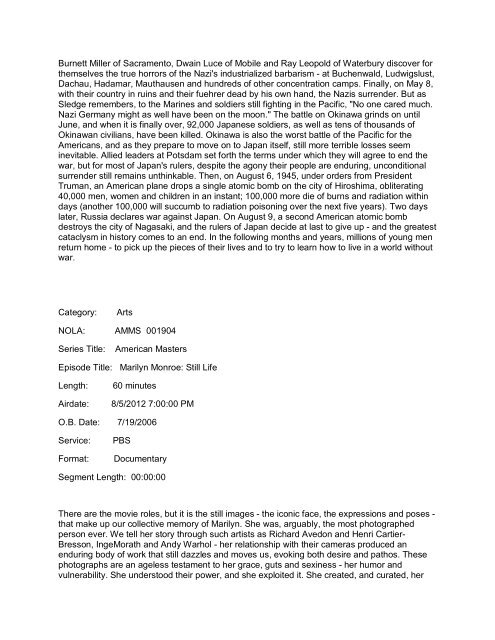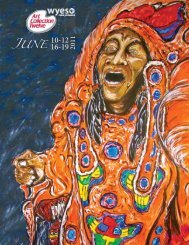Quarterly Program Topic Report July 1-15, 2012 Category ... - WYES
Quarterly Program Topic Report July 1-15, 2012 Category ... - WYES
Quarterly Program Topic Report July 1-15, 2012 Category ... - WYES
Create successful ePaper yourself
Turn your PDF publications into a flip-book with our unique Google optimized e-Paper software.
Burnett Miller of Sacramento, Dwain Luce of Mobile and Ray Leopold of Waterbury discover for<br />
themselves the true horrors of the Nazi's industrialized barbarism - at Buchenwald, Ludwigslust,<br />
Dachau, Hadamar, Mauthausen and hundreds of other concentration camps. Finally, on May 8,<br />
with their country in ruins and their fuehrer dead by his own hand, the Nazis surrender. But as<br />
Sledge remembers, to the Marines and soldiers still fighting in the Pacific, "No one cared much.<br />
Nazi Germany might as well have been on the moon." The battle on Okinawa grinds on until<br />
June, and when it is finally over, 92,000 Japanese soldiers, as well as tens of thousands of<br />
Okinawan civilians, have been killed. Okinawa is also the worst battle of the Pacific for the<br />
Americans, and as they prepare to move on to Japan itself, still more terrible losses seem<br />
inevitable. Allied leaders at Potsdam set forth the terms under which they will agree to end the<br />
war, but for most of Japan's rulers, despite the agony their people are enduring, unconditional<br />
surrender still remains unthinkable. Then, on August 6, 1945, under orders from President<br />
Truman, an American plane drops a single atomic bomb on the city of Hiroshima, obliterating<br />
40,000 men, women and children in an instant; 100,000 more die of burns and radiation within<br />
days (another 100,000 will succumb to radiation poisoning over the next five years). Two days<br />
later, Russia declares war against Japan. On August 9, a second American atomic bomb<br />
destroys the city of Nagasaki, and the rulers of Japan decide at last to give up - and the greatest<br />
cataclysm in history comes to an end. In the following months and years, millions of young men<br />
return home - to pick up the pieces of their lives and to try to learn how to live in a world without<br />
war.<br />
<strong>Category</strong>:<br />
Arts<br />
NOLA: AMMS 001904<br />
Series Title:<br />
American Masters<br />
Episode Title: Marilyn Monroe: Still Life<br />
Length:<br />
Airdate:<br />
60 minutes<br />
8/5/<strong>2012</strong> 7:00:00 PM<br />
O.B. Date: 7/19/2006<br />
Service:<br />
Format:<br />
PBS<br />
Documentary<br />
Segment Length: 00:00:00<br />
There are the movie roles, but it is the still images - the iconic face, the expressions and poses -<br />
that make up our collective memory of Marilyn. She was, arguably, the most photographed<br />
person ever. We tell her story through such artists as Richard Avedon and Henri Cartier-<br />
Bresson, IngeMorath and Andy Warhol - her relationship with their cameras produced an<br />
enduring body of work that still dazzles and moves us, evoking both desire and pathos. These<br />
photographs are an ageless testament to her grace, guts and sexiness - her humor and<br />
vulnerability. She understood their power, and she exploited it. She created, and curated, her







